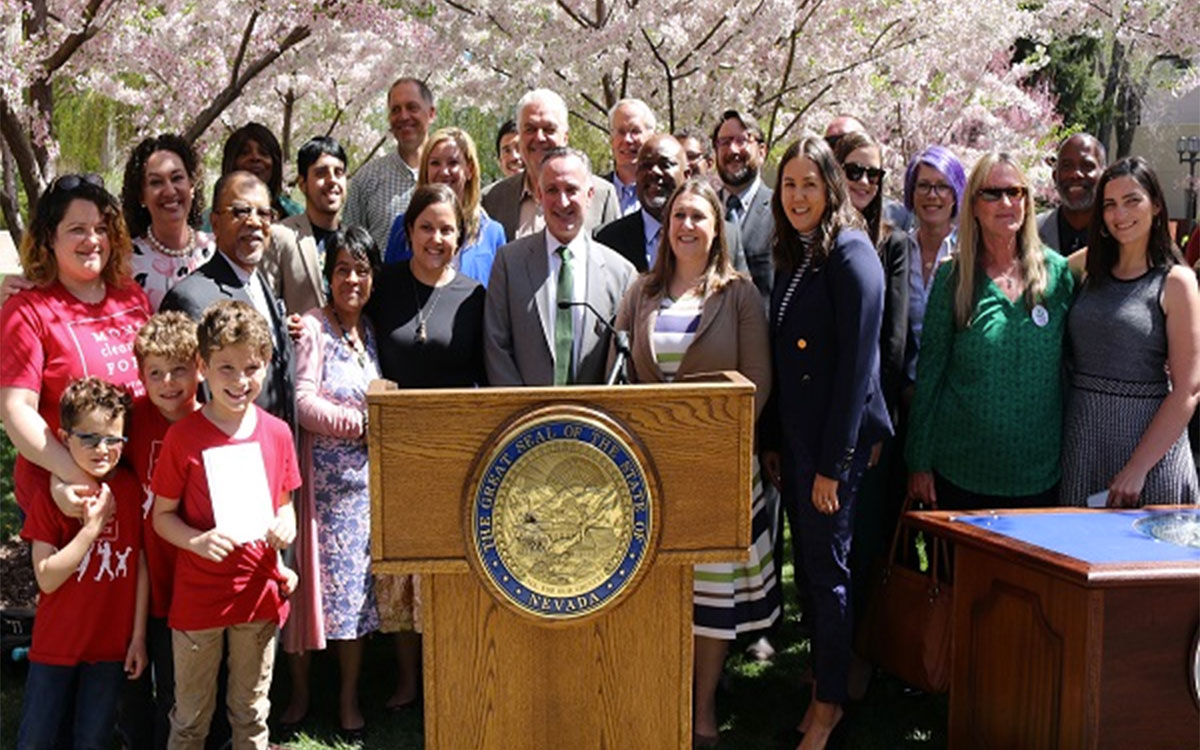Today, Nevada Governor Sisolak signed Senate Bill 358 into law, putting the state on a path to a cleaner, greener, and fairer energy future. For years, impacted communities, the Sierra Club, and other partners have worked to clean up Nevada’s energy mix; this bill significantly moves us to that goal by increasing the renewable portfolio standard (RPS) to 50% by 2030 with the goal of 100% by 2050. Nevada becomes a forerunner in the national transition to clean energy as the fourth U.S. state to aim for 100 percent clean energy, joining California, Hawaii, and New Mexico.
A decade ago, Nevada relied heavily on coal while clean energy was just a fraction of the state’s energy mix. The state’s dependency on coal had a particularly damaging impact on the Moapa Band of Paiutes, who lived just down wind of the Reid Gardner Generating Station, a 557-megawatt plant built in the 60s that expanded in the two decades that followed.
To raise awareness on the impacts of burning toxic coal right next to where members of the tribe live and play, the Moapa Band of Paiutes and Sierra Club held a 50 mile walk from the Reid Gardner Coal Plant to the Federal building in downtown Las Vegas.
This moment served as a catalyst for an issue that had been ignored for decades: from there, the movement to reinvent power moved quickly. In his opening remarks for the 2012 National Clean Energy Summit, Nevada Senator Reid called for the closure of the Reid Gardner plant, stating: “it’s time to close the dirty relic we’ve built” going on to say “the first step should be turn out the lights on Reid Gardner, and turn them out forever.”
Subsequently, a domino effect of coal plant closures began sweeping the state, as legislators, environmental organizations, local utility NV Energy, and communities sought to bring clean energy to Nevada. Senator Reid’s comments at the 2012 National Clean Energy Summit was followed by the 2013 Legislative Session where legislators voted to retire the Reid Garnder coal plant through the passage of Senate Bill 123. One down, two to go.
As Reid Gardner was set for retirement we turned our attention the the Valmy Coal Plant in Northern Nevada. The campaign to retire Valmy took multiple years and more regulatory dockets then I can count. The Valmy retirement was proposed in NV Energy’s 2018 long-term energy plan. At the same time NV Energy was looking to decommission its coal plant, voters were going to the polls to make their voices heard on what kind of energy future they wanted for their state. Nevadans chose to support Question 6, an initiative that would increase Nevada’s renewable portfolio standard to 50% by 2050. A month after voters took to the polls, the Nevada Public Utilities Commission unanimously voted to retire the Valmy Coal Plant. Not only was Valmy set to retire, but the plan also approved 1,001 MW of new solar and 100 MW of new storage that will all come online before 2023. Two coal plants down, one to go.
Today, We Forever Changed Energy in Nevada
The statewide shift away from dirty, expensive coal to sustainable and affordable renewable energy has just come to a head today. Less then a year after Nevada voters demonstrated overwhelming support for a clean energy future via Question 6, state legislators unanimously passed a bill to make that future a reality. Earth Day 2019 will go down in Nevada history as the day the clean energy vision of voters and legislators was made into law by Governor Sisolak.
As our work moves forward and we build and reinvent how Nevada is powered, we will continue to uphold the values that brought us to this victory. Our fights brings us to the closure of the final coal plant in the state, the TS Power Plant. SB 358 makes keeping that coal plant operational an expensive operation. While we prepare for a coal free future in Nevada, we also look to help the state develop further. We will work to embrace clean energy technologies that will quickly moves us away from coal, oil, and gas to 100 percent renewable, ensure that the benefits of the renewable sector is accessible for everyone, facilitate smooth and just transitions away from old energy industries, and clean up the legacy pollution of burning fossil fuels.
